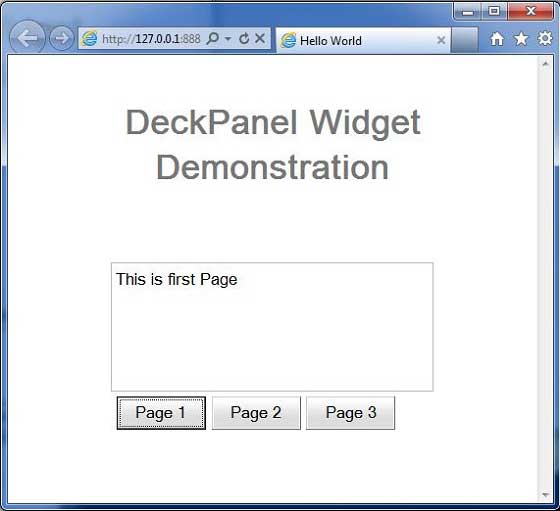
- GWT - Home
- GWT - Overview
- GWT - Environment Setup
- GWT - Applications
- GWT - Create Application
- GWT - Deploy Application
- GWT - Style with CSS
- GWT - Basic Widgets
- GWT - Form Widgets
- GWT - Complex widgets
- GWT - Layout Panels
- GWT - Event Handling
- GWT - Custom Widgets
- GWT - UIBinder
- GWT - RPC Communication
- GWT - JUnit Integration
- GWT - Debugging Application
- GWT - Internationalization
- GWT - History Class
- GWT - Bookmark Support
- GWT - Logging Framework
GWT - DeckPanel Widget
Introduction
The DeckPanel widget represents a panel that displays all of its child widgets in a 'deck', where only one can be visible at a time. It is used by TabPanel.
Class Declaration
Following is the declaration for com.google.gwt.user.client.ui.DeckPanel class −
public class DeckPanel
extends ComplexPanel
implements HasAnimation, InsertPanel.ForIsWidget
Class Constructors
| Sr.No. | Constructor & Description |
|---|---|
| 1 |
DeckPanel() Constructor for DeckPanel. |
Class Methods
| Sr.No. | Function name & Description |
|---|---|
| 1 |
void add(Widget w) Adds a child widget. |
| 2 |
int getVisibleWidget() Gets the index of the currently-visible widget. |
| 3 |
void insert(IsWidget w, int beforeIndex) |
| 4 |
void insert(Widget w, int beforeIndex) Inserts a child widget before the specified index. |
| 5 |
boolean isAnimationEnabled() Returns true if animations are enabled, false if not. |
| 6 |
boolean remove(Widget w) Removes a child widget. |
| 7 |
void setAnimationEnabled(boolean enable) Enable or disable animations. |
| 8 |
void showWidget(int index) Shows the widget at the specified index. |
Methods Inherited
This class inherits methods from the following classes −
com.google.gwt.user.client.ui.UIObject
com.google.gwt.user.client.ui.Widget
com.google.gwt.user.client.ui.Panel
com.google.gwt.user.client.ui.ComplexPanel
java.lang.Object
DeckPanel Widget Example
This example will take you through simple steps to show usage of a DeckPanel Widget in GWT. Follow the following steps to update the GWT application we created in GWT - Create Application chapter −
| Step | Description |
|---|---|
| 1 | Create a project with a name HelloWorld under a package com.tutorialspoint as explained in the GWT - Create Application chapter. |
| 2 | Modify HelloWorld.gwt.xml, HelloWorld.css, HelloWorld.html and HelloWorld.java as explained below. Keep rest of the files unchanged. |
| 3 | Compile and run the application to verify the result of the implemented logic. |
Following is the content of the modified module descriptor src/com.tutorialspoint/HelloWorld.gwt.xml.
<?xml version = "1.0" encoding = "UTF-8"?> <module rename-to = 'helloworld'> <!-- Inherit the core Web Toolkit stuff. --> <inherits name = 'com.google.gwt.user.User'/> <!-- Inherit the default GWT style sheet. --> <inherits name = 'com.google.gwt.user.theme.clean.Clean'/> <!-- Specify the app entry point class. --> <entry-point class = 'com.tutorialspoint.client.HelloWorld'/> <!-- Specify the paths for translatable code --> <source path = 'client'/> <source path = 'shared'/> </module>
Following is the content of the modified Style Sheet file war/HelloWorld.css.
body {
text-align: center;
font-family: verdana, sans-serif;
}
h1 {
font-size: 2em;
font-weight: bold;
color: #777777;
margin: 40px 0px 70px;
text-align: center;
}
.deckpanel {
border: 1px solid #BBBBBB;
padding: 3px;
}
Following is the content of the modified HTML host file war/HelloWorld.html.
<html>
<head>
<title>Hello World</title>
<link rel = "stylesheet" href = "HelloWorld.css"/>
<script language = "javascript" src = "helloworld/helloworld.nocache.js">
</script>
</head>
<body>
<h1>DeckPanel Widget Demonstration</h1>
<div id = "gwtContainer"></div>
</body>
</html>
Let us have following content of Java file src/com.tutorialspoint/HelloWorld.java which will demonstrate use of DeckPanel widget.
package com.tutorialspoint.client;
import com.google.gwt.core.client.EntryPoint;
import com.google.gwt.event.dom.client.ClickEvent;
import com.google.gwt.event.dom.client.ClickHandler;
import com.google.gwt.user.client.ui.Button;
import com.google.gwt.user.client.ui.DeckPanel;
import com.google.gwt.user.client.ui.HorizontalPanel;
import com.google.gwt.user.client.ui.Label;
import com.google.gwt.user.client.ui.RootPanel;
import com.google.gwt.user.client.ui.VerticalPanel;
public class HelloWorld implements EntryPoint {
public void onModuleLoad() {
// Create DeckPanel widget
final DeckPanel deckPanel = new DeckPanel();
deckPanel.setSize("300px", "120px");
deckPanel.setStyleName("deckpanel");
// Create lables to add to deckpanel
Label label1 = new Label("This is first Page");
Label label2 = new Label("This is second Page");
Label label3 = new Label("This is third Page");
// Add labels to deckpanel
deckPanel.add(label1);
deckPanel.add(label2);
deckPanel.add(label3);
//show first label
deckPanel.showWidget(0);
//create button bar
HorizontalPanel buttonBar = new HorizontalPanel();
buttonBar.setSpacing(5);
// create button and add click handlers
// show different labels on click of different buttons
Button button1 = new Button("Page 1");
button1.addClickHandler(new ClickHandler() {
@Override
public void onClick(ClickEvent event) {
deckPanel.showWidget(0);
}
});
Button button2 = new Button("Page 2");
button2.addClickHandler(new ClickHandler() {
@Override
public void onClick(ClickEvent event) {
deckPanel.showWidget(1);
}
});
Button button3 = new Button("Page 3");
button3.addClickHandler(new ClickHandler() {
@Override
public void onClick(ClickEvent event) {
deckPanel.showWidget(2);
}
});
buttonBar.add(button1);
buttonBar.add(button2);
buttonBar.add(button3);
VerticalPanel vPanel = new VerticalPanel();
vPanel.add(deckPanel);
vPanel.add(buttonBar);
// Add the widgets to the root panel.
RootPanel.get().add(vPanel);
}
}
Once you are ready with all the changes done, let us compile and run the application in development mode as we did in GWT - Create Application chapter. If everything is fine with your application, this will produce following result −
